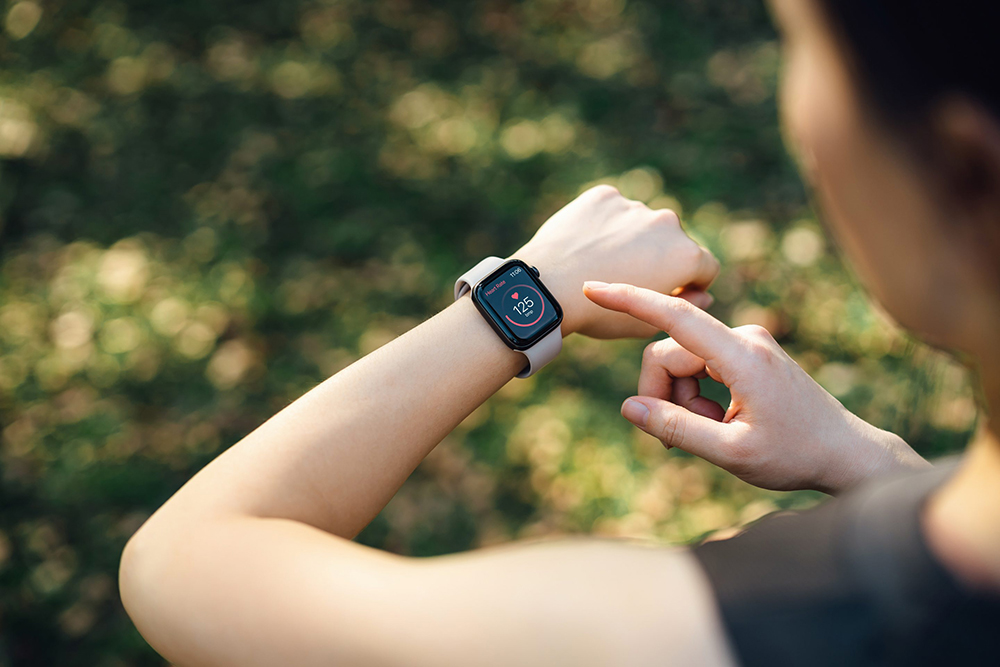靠手表能提前七年诊断帕金森病?

苹果(Apple)、谷歌(Google)和佳明(Garmin)等公司制造的智能手表,深受热爱健身并希望掌握运动指标的消费者喜爱。不过智能手表对健康的益处可能不只步数统计,研究人员发现,可穿戴技术可能成为神经退行性运动疾病帕金森病早期诊断的关键。
帕金森病确诊通常需要数年,因为随着时间推移,运动迟缓、无意识颤抖和肌肉僵硬等症状发展速度非常缓慢。
目前帕金森病无法治愈,不过如果确诊够早,患者就能够服药、接受治疗,某些情况下还可以通过手术提高生活质量。
这正是位于威尔士的卡迪夫大学(Cardiff University)的一个科研团队希望解决的问题。
卡迪夫大学神经科学与心理健康创新研究所(Neuroscience and Mental Health Innovation Institute)和英国痴呆症研究所(U.K. Dementia Research Institute)的专家利用人工智能模型,分析了103,712名智能手表佩戴者的加速度,也就是运动中的加速度数据。
跟踪一周的运动速度后,计算机程序不仅能够识别已经确诊帕金森病的患者,也可以鉴别患病早期但尚未确诊的患者。
研究人员还能够精准定位诊断时间,发现确诊七年之前就可以发现早期症状。
卡迪夫大学神经科学与心理健康创新研究所的临床高级讲师凯瑟琳·皮尔解释道:“帕金森病是使用多巴胺的脑细胞减少引起的进行性运动障碍。然而到确诊时,脑细胞已经损失约50%至70%。所以该病早期诊断很困难。”
“我们知道,随着帕金森病的发展,活动速度也会发生变化,因此我们着重研究加速度能否作为帕金森病的标志物(早期预兆和症状),从而尽早诊断。”
“前所未有”的发现
根据市场和消费者洞察网站Statista的研究,今年智能手表用户将达到2.1亿人。
随着时间推移,数字只会上升。数据预测,到2027年,将有近2.3亿人使用可穿戴技术。
卡迪夫大学痴呆症研究所(Cardiff University's Dementia Research Institute)的辛西娅·桑多尔补充说,将消费者需求与科学视角结合可能彻底改变行业。她指出,跟踪加速度能够特别加深了解帕金森病,不过对研究小组跟踪的其他疾病没有什么指示作用。
科学家称,相关结果非常“独特”,所以不会与其他疾病或衰老混淆。
桑多尔继续表示:“研究结果表明,可以大规模利用加速度识别帕金森病高危人群。”
“临床环境里由于时间、成本、方便程度和灵敏度等原因,无法实现连续或半连续监测个人数据。另一方面,每天都有数百万人佩戴能够收集加速度数据的智能设备。”
下一步怎么做?
该篇发表于《自然医学》(Nature Medicine)杂志的论文警告称,这一发现尚需更多研究支持。
文章称,尽管团队努力“淡化”偏见,但数据来源只有英国生物银行(UK Biobank),因为只有该处数据在规模和数据量方面可以供程序运行。英国生物银行掌握着该国超过50万人的健康详细数据。
世界卫生组织(World Health Organization)曾经警告过医学转型中的偏见,尤其是人工智能模型相关问题。
今年5月,世界卫生组织发文称:“本机构积极鼓励适当使用包括大型语言模型在内的技术,为医疗专业人员、患者、研究人员和科学家提供支持。不过有人担心,虽然通常来说社会对技术会比较谨慎,然而对大型语言模型却有些纵容。”
“具体包括广泛遵守透明、包容、公众参与、专家监督和严格评估等关键价值观。”
撰写帕金森病论文的团队呼吁,其他研究人员在现有发现的基础上更进一步。该团队写道,如果其研究的局限性获得解决,可穿戴设备和健康传感器设备就有望“推动医学进入数字健康时代”,从而改善医疗行业,降低成本并提升便利性。(财富中文网)
译者:夏林
苹果(Apple)、谷歌(Google)和佳明(Garmin)等公司制造的智能手表,深受热爱健身并希望掌握运动指标的消费者喜爱。不过智能手表对健康的益处可能不只步数统计,研究人员发现,可穿戴技术可能成为神经退行性运动疾病帕金森病早期诊断的关键。
帕金森病确诊通常需要数年,因为随着时间推移,运动迟缓、无意识颤抖和肌肉僵硬等症状发展速度非常缓慢。
目前帕金森病无法治愈,不过如果确诊够早,患者就能够服药、接受治疗,某些情况下还可以通过手术提高生活质量。
这正是位于威尔士的卡迪夫大学(Cardiff University)的一个科研团队希望解决的问题。
卡迪夫大学神经科学与心理健康创新研究所(Neuroscience and Mental Health Innovation Institute)和英国痴呆症研究所(U.K. Dementia Research Institute)的专家利用人工智能模型,分析了103,712名智能手表佩戴者的加速度,也就是运动中的加速度数据。
跟踪一周的运动速度后,计算机程序不仅能够识别已经确诊帕金森病的患者,也可以鉴别患病早期但尚未确诊的患者。
研究人员还能够精准定位诊断时间,发现确诊七年之前就可以发现早期症状。
卡迪夫大学神经科学与心理健康创新研究所的临床高级讲师凯瑟琳·皮尔解释道:“帕金森病是使用多巴胺的脑细胞减少引起的进行性运动障碍。然而到确诊时,脑细胞已经损失约50%至70%。所以该病早期诊断很困难。”
“我们知道,随着帕金森病的发展,活动速度也会发生变化,因此我们着重研究加速度能否作为帕金森病的标志物(早期预兆和症状),从而尽早诊断。”
“前所未有”的发现
根据市场和消费者洞察网站Statista的研究,今年智能手表用户将达到2.1亿人。
随着时间推移,数字只会上升。数据预测,到2027年,将有近2.3亿人使用可穿戴技术。
卡迪夫大学痴呆症研究所(Cardiff University's Dementia Research Institute)的辛西娅·桑多尔补充说,将消费者需求与科学视角结合可能彻底改变行业。她指出,跟踪加速度能够特别加深了解帕金森病,不过对研究小组跟踪的其他疾病没有什么指示作用。
科学家称,相关结果非常“独特”,所以不会与其他疾病或衰老混淆。
桑多尔继续表示:“研究结果表明,可以大规模利用加速度识别帕金森病高危人群。”
“临床环境里由于时间、成本、方便程度和灵敏度等原因,无法实现连续或半连续监测个人数据。另一方面,每天都有数百万人佩戴能够收集加速度数据的智能设备。”
下一步怎么做?
该篇发表于《自然医学》(Nature Medicine)杂志的论文警告称,这一发现尚需更多研究支持。
文章称,尽管团队努力“淡化”偏见,但数据来源只有英国生物银行(UK Biobank),因为只有该处数据在规模和数据量方面可以供程序运行。英国生物银行掌握着该国超过50万人的健康详细数据。
世界卫生组织(World Health Organization)曾经警告过医学转型中的偏见,尤其是人工智能模型相关问题。
今年5月,世界卫生组织发文称:“本机构积极鼓励适当使用包括大型语言模型在内的技术,为医疗专业人员、患者、研究人员和科学家提供支持。不过有人担心,虽然通常来说社会对技术会比较谨慎,然而对大型语言模型却有些纵容。”
“具体包括广泛遵守透明、包容、公众参与、专家监督和严格评估等关键价值观。”
撰写帕金森病论文的团队呼吁,其他研究人员在现有发现的基础上更进一步。该团队写道,如果其研究的局限性获得解决,可穿戴设备和健康传感器设备就有望“推动医学进入数字健康时代”,从而改善医疗行业,降低成本并提升便利性。(财富中文网)
译者:夏林
Smartwatches made by the likes of Apple, Google and Garmin are beloved by fitness-conscious consumers who want to keep on top of their metrics, but the health benefits may now go beyond a step count with researchers finding that the wearable tech could be the key to unlocking early diagnosis of neurodegenerative movement disease, Parkinson’s.
Parkinson’s can often take years to diagnose as the symptoms—slow movement, involuntary shaking and stiff muscles to name a few—can develop so slowly over time.
The disease is currently incurable, though if diagnosed early enough the quality of life of patients can be bolstered by medicine, therapies and in some cases surgery.
This is the part of the problem a team of scientists at Wales’s Cardiff University hope to have cracked.
The experts at the university’s Neuroscience and Mental Health Innovation Institute (NMHII) and the U.K. Dementia Research Institute analyzed the accelerometry—the acceleration of motion—in 103,712 smartwatch wearers using artificial intelligence models.
By tracking the speed of motion over the course of a week, the computer programs were able not only to identify patients who had already been diagnosed with Parkinson’s but also those who were in the early stages of the disease who had not yet been diagnosed.
The researchers were also able to pinpoint when a clinical diagnosis would be made, with early onset symptoms being identified up to seven years before that point.
Dr Kathryn Peall, Clinical Senior Lecturer in the NMHII, explained: “Parkinson’s disease is a progressive movement disorder caused by the loss of brain cells that use dopamine. However, by the time of clinical diagnosis, approximately 50-70% of these brain cells will have been lost. This makes early diagnosis of the disease difficult.
“We know that as Parkinson’s disease develops, there are changes to the speed of movement, so we investigated whether accelerometry could work as a prodromal marker [early signs and symptoms] for Parkinson’s disease, and ultimately allow for earlier diagnosis.”
An “unprecedented” discovery
According to research from market and consumer insights site Statista, 210 million people will be using smartwatches this year.
That figure only goes up as time goes on—by 2027 the data predicts nearly 230 million people will be making the most of wearable technologies.
Combining this consumer demand with scientific insight could be a game changer, added Dr Cynthia Sandor of Cardiff University’s Dementia Research Institute, who said tracking accelerometry gave unique insights into Parkinson’s but not any other disorders the team examined.
The scientists said the results were so “distinct” that they could not be confused with other diseases or aging.
Dr Sandor continued: “It suggests that accelerometry could be used to identify those at elevated risk for Parkinson’s disease on an unprecedented scale.
“In a clinical setting, continuous or semi-continuous monitoring of individuals can’t be achieved because of time, cost, accessibility and sensitivity. But smart devices capable of collecting accelerometer data are worn daily by millions of people.”
What next?
The paper, which was published in the journal Nature Medicine, does caveat the discovery with the need for more research.
The article says that although the team sought to “mitigate” against any biases they only had one data set—from the UK Biobank, an in-depth health database of more than half a million people in the country—as it was the only one large enough in terms of scale and volume of data to run the computer programs.
Bias in medical transformation is an issue the World Health Organization has issued a warning on—particularly in relation to artificial intelligence models.
In May the organization wrote: “While WHO is enthusiastic about the appropriate use of technologies, including large language models, to support health-care professionals, patients, researchers and scientists, there is concern that caution that would normally be exercised for any new technology is not being exercised consistently with LLMs.
“This includes widespread adherence to key values of transparency, inclusion, public engagement, expert supervision, and rigorous evaluation.”
The team behind the Parkinson’s paper has called for other researchers to build on their findings, writing that if the limitations to their work are addressed then wearables and health-sensor devices have the “ability to transition medicine into a digital health era”, thus improving healthcare itself as well as reducing costs and increasing accessibility.













